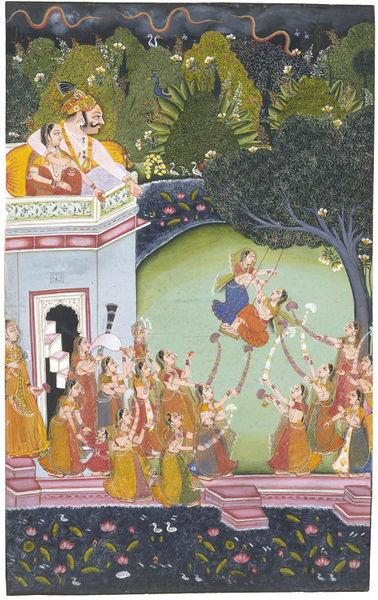Original Painting From Victoria London
Salwa king contemporary to Krishna

Yet another Salwa king (3:12, 7:11) attacked Dwaraka, this Salwa king was an ally of Shishupala, Dantavakra and Rukmi. According to the narration in the epic, he possessed an aircraft known as Saubha Vimana and used it for travel and for aerial warfare
Raja (Raja Jagat Singh II, 1694-1752, possibly of Jaipur) and lady watching from a roof-top the Tij,

Painting in opaque watercolour on paper depicting the month of Sawan (July-August). A Raja (Raja Jagat Singh II, 1694-1752, possibly of Jaipur) and lady watching from a roof-top the Tij, or Swing Festival, performed at Bundi in the rains. An illustration to a Barahmasa or set of verses describing the ways of lovers in the twelve months.
Place of Origin
Bundi (made)
Date
ca. 1770 (made)
Artist/maker
In this painting, a Rajput nobleman and his companion watch a celebration of the festival of Teej, held to mark the arrival of the monsoon. The coming of the rains signifies fecundity and renewal, as seen in the verdant depiction of the garden and the snake-like lightening in the sky. In fine clothes and with henna-painted hands, women carry an effigy of the female deity Parvati, holding floral fronds aloft, and swing from a mango tree as lightening flashes across the sky.

Matsya
- Object:Painting
- Place of origin:Kolkata (made)
- Date:ca. 1885 (made)
- Artist/Maker:Unknown
- Materials and Techniques:Painted in opaque watercolour on paper
- Museum number:IS.592-1950
- Gallery location:In Storage


the capture of Bundi fort in Rajasthan by the Mughal army in 1577
The Akbarnama was written in Persian by Akbar’s court historian and biographer, Abu’l Fazl, between 1590 and 1596, and the V&A’s partial copy of the manuscript is thought to have been illustrated between about 1592 and 1595. This is thought to be the earliest illustrated version of the text, and drew upon the expertise of some of the best royal artists of the time. Many of these are listed by Abu’l Fazl in the third volume of the text, the A’in-i Akbari, and some of these names appear in the V&A illustrations, written in red ink beneath the pictures, showing that this was a royal copy made for Akbar himself. After his death, the manuscript remained in the library of his son Jahangir, from whom it was inherited by Shah Jahan.
The V&A purchased the manuscript in 1896 from Frances Clarke, the widow of Major General John Clarke, who bought it in India while serving as Commissioner of Oudh between 1858 and 1862.
Architectural drawing of Tirumala Nayak at Madura,
- Object:Drawing
- Place of origin:Madura (made)
- Date:ca. 1780 (made)
- Artist/Maker:Unknown
- Materials and Techniques:Pen and Ink
- Museum number:AL.7766:34
- Gallery location:In Storage
- Download image
Architectural drawing of Tirumala Nayak at Madura,
- Object:Drawing
- Place of origin:Madura (made)
- Date:ca. 1780 (made)
- Artist/Maker:Unknown
- Materials and Techniques:Pen and Ink
- Museum number:AL.7766:139
- Gallery location:In Storage


0 comments: